
Transform Your Supply Chain Planning and Marketing Strategies with Google Cloud and SAP Integration

Transform Your Supply Chain Planning and Marketing Strategies with Google Cloud and SAP Integration
March 24, 2023 | Manju Devadas
Blog / Pluto7’s Demand ML Solution on BTP: Improved Demand Forecasting with Google Data on SAP IBP
I am happy to introduce the launch of our new solution – Demand ML on SAP Business Technology Platform (BTP). This innovative solution aims to empower businesses with real-time demand sensing, better forecasting, assortment, and category planning capabilities.
Traditional demand forecasting is no longer sufficient in today’s business landscape. These forecasts rely on historical sales data and assume stable demand and consumer behavior, which is not always the case.
Aggregated demand forecasts can hide the daily patterns, trends, and nuances of consumer behavior, leaving retailers with a surface-level view of demand that is not granular enough to make informed decisions.
Without external signals, the forecast remains less accurate. This is especially problematic when forecasting seasonal and slow-moving products, where there is little data to work with.
Without granular forecasts, planners cannot fully understand the complex relationships consumers have with products, leading to suboptimal decisions across sourcing, merchandising, and buying.
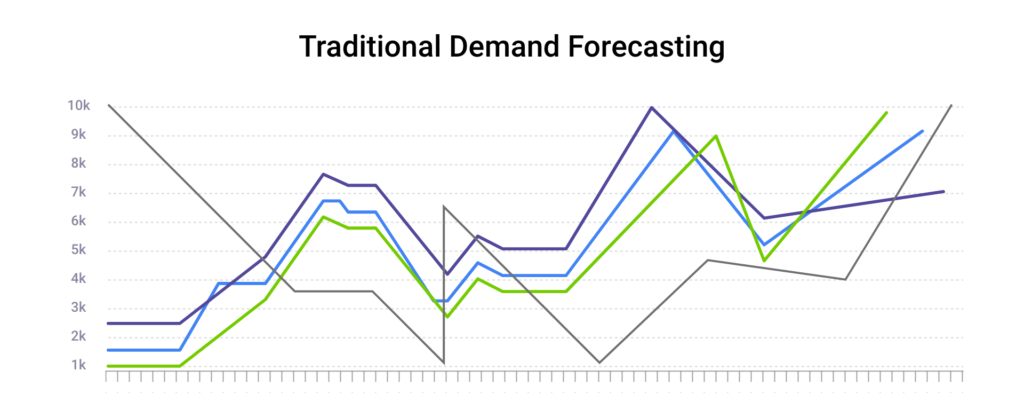
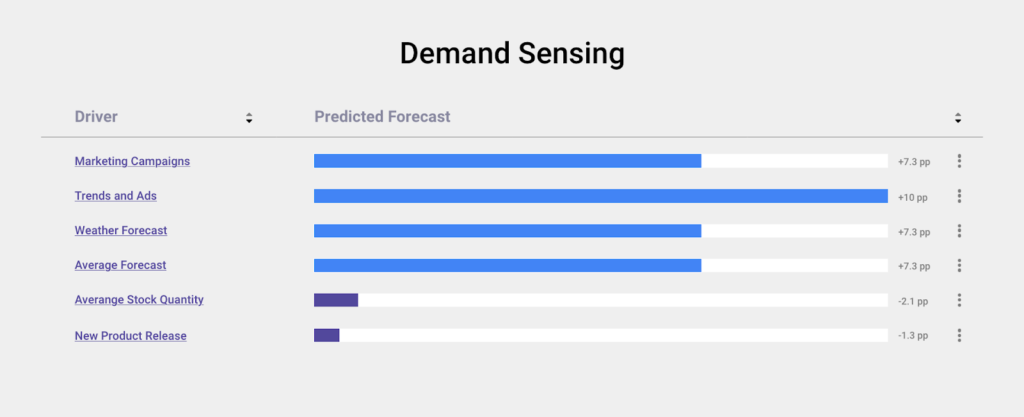
Pluto7’s Demand ML solution is a robust data platform that seamlessly integrates various business systems and processes, providing real-time demand sensing and improved forecasting, assortment, and category planning capabilities.
By combining internal and external data from over 250+ datasets, including Google marketing data and other critical data signals, SAP users can gain granular insights into external factors impacting demand, such as consumer trends, behavior, and demographics.
With this information at their fingertips, businesses can make informed decisions and stay ahead of the competition.
Despite advancements in technology, many organizations still rely on a siloed approach to forecasting and planning, with planners working on Excel and manually compiling data from various sources. This approach often leads to communication breakdowns and inconsistencies in data, resulting in poor decision-making and missed opportunities.
To overcome these challenges, blending data from external sources becomes essential in ensuring a more accurate and comprehensive approach to forecasting and planning.
A survey by Ventana Research revealed that a mere 24% of organizations have successfully integrated planning processes across all lines of business, resulting in a significant waste of time and resources due to inconsistent data and poor collaboration.
Connected planning offers a powerful solution to break down silos by integrating data from across the organization into a single source of truth. By leveraging external data signals and advanced technologies like machine learning and predictive analytics, businesses can gain granular insights into market trends and customer demand signals that were previously hidden.
This enables planners to collaborate in real-time and make decisions based on accurate, up-to-date information from internal and external sources, ultimately resulting in more informed and effective planning decisions.
By breaking down silos and integrating data across the organization, connected planning enables planners to make better decisions faster, resulting in increased efficiency, cost savings, and improved customer satisfaction.
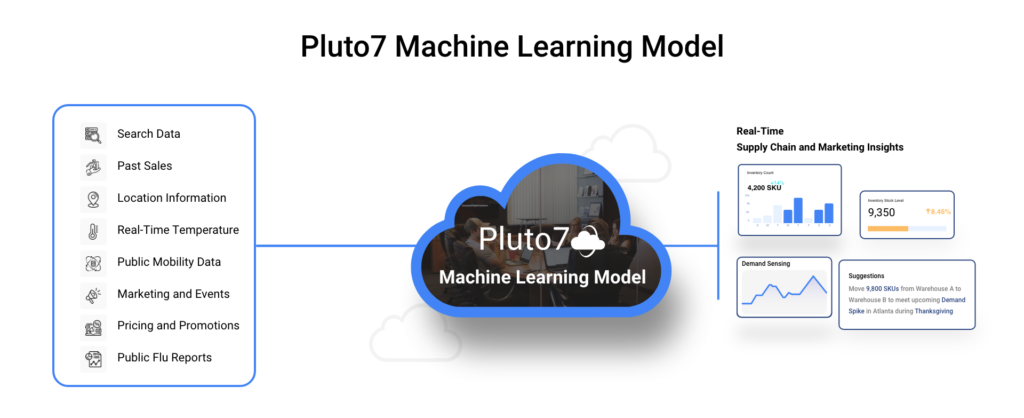
Despite the growing interest in AI and ML, many companies are facing challenges in adopting these technologies due to their underlying data infrastructure being outdated and ill-equipped. It is not uncommon for customers to request advanced analytics on incomplete or inaccurate datasets.
To address this need, we have developed a data platform that operates on the GCP platform. The primary goal of this platform is to unify and centralize enterprise data, generate insights, and push the results back to the customer’s cloud instance.
SAP Integrated Business Planning (IBP) provides end-to-end planning capabilities that enable businesses to connect demand, inventory, and supply planning. However, SAP IBP is a traditional demand forecasting tool that relies solely on historical data for forecasting, and it often falls short in trying to capture the complexity of real-world demand signals. That’s where the integration capabilities of Pluto7 come into play with Demand ML bringing in the 250+ external data signals.
The Demand ML solution is capable of blending datasets from various SAP and non-SAP data sources, including ERP and non-ERP systems such as SAP warehouse systems, SAP inventory systems, sales orders, CRM, weather/location data, Google Ad Tech data, and trends.
Combining these datasets with SAP’s demand forecasting tool, it provides a more comprehensive view of external demand signals.
Unlock the potential of demand sensing alerts to gain detailed insights into your demand planning, sales, and marketing data, empowering you to take swift and informed actions. With the ability to analyze a wide range of external signals, demand sensing alerts provide a granular view of your business operations in real-time.
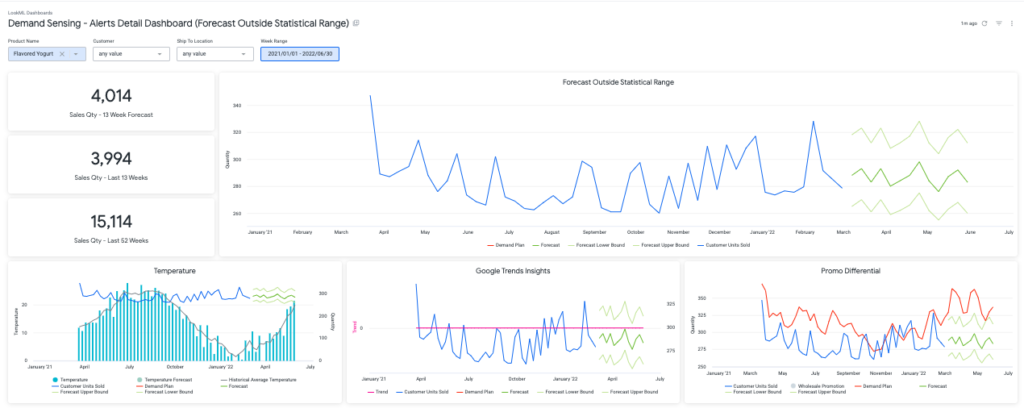
This dashboard offers valuable insights on sales quantity within a specific timeframe, sorted by ship-to location, product name, and customer, based on customer trends. It also highlights the trends occurring in various aspects of the products being sold, giving a clear picture of the current market demand. The dashboard is highly interactive and can be filtered based on various criteria, which can be used to modify the information displayed in the tiles.
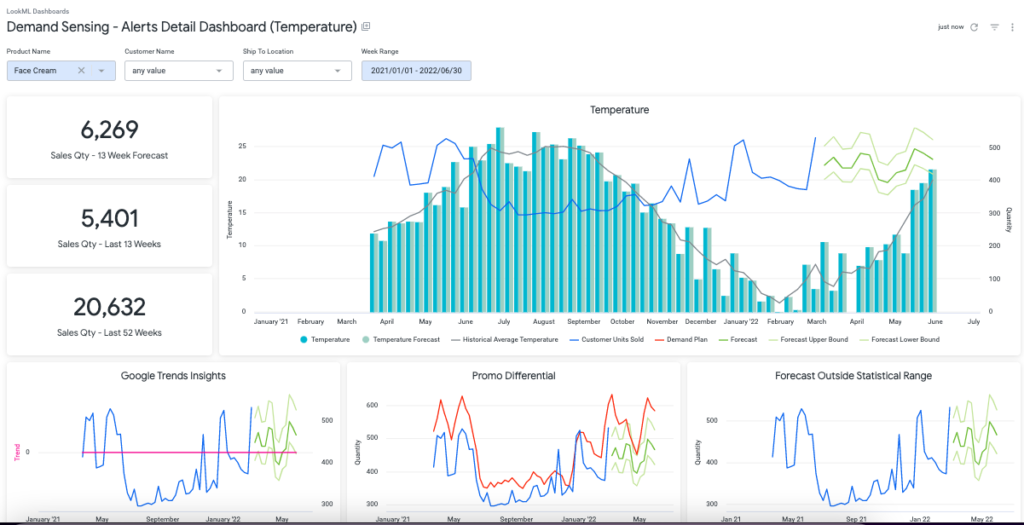
This dashboard offers a powerful tool for measuring promo differentials for a given product. By presenting a clear comparison of actual and forecasted results, it allows users to track the effectiveness of different promotional activities and identify any discrepancies between the forecasted and actual sales.
The right-side tile of the dashboard provides a prominent display of the actual number of units sold and the forecasted quantity for the next 13 weeks, alongside the demand plan. Users can compare these figures to determine the success of different promotions and campaigns and adjust their marketing strategies accordingly.
It also enables users to analyze the impact of different factors, such as seasonality and market trends, on a product’s sales. By tracking these factors, users can make informed decisions about future promotional activities and optimize their supply chain operations to meet customer demand.
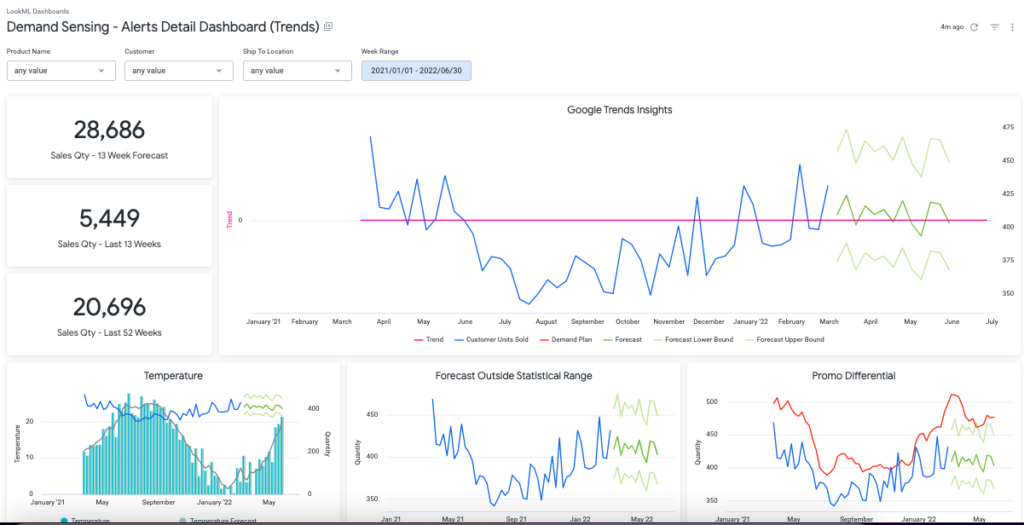
This dashboard offers valuable insights on sales quantity within a specific timeframe, sorted by ship-to location, product name, and customer, based on customer trends. It also highlights the trends occurring in various aspects of the products being sold, giving a clear picture of the current market demand. The dashboard is highly interactive and can be filtered based on various criteria, which can be used to modify the information displayed in the tiles.

This dashboard utilizes Google’s weather data to provide insights on sales quantity within a specific timeframe, sorted by ship-to location, product name, and customer based on temperature. Users can filter the data based on location, customer, product, and date range to customize the dashboard and display only relevant information.
Let’s consider a scenario where a cosmetic company produces and sells face cream.
By incorporating Google’s weather data into their demand planning, they can analyze how temperature changes impact their sales of face cream. They may notice that during colder months, sales of face cream increase, while sales decrease during hotter months. With this insight, they can adjust their inventory and marketing strategies, stocking up on face cream during colder months and promoting it more heavily during those periods.
Accurate forecasting relies on having high-quality data that is fit for building statistical models. The Demand ML solution’s data quality analysis feature allows SAP IBP users to assess the suitability of their data for forecasting and identify areas where the quality needs to be improved. If the data quality is found to be lacking, the tool will advise the user on how to improve the data quality before using it for forecasting models.
With a combination of capabilities on SAP BTP and GCP, we are now able to provide better data quality analysis capabilities with Demand ML.
Pluto7’s Demand ML solution on SAP BTP offers a data decomposition feature that identifies the key link in the data from trends to noise components. This involves establishing a trend in the data uploaded and breaking it down into level, trend, seasonality, and noise components. By doing so, it improves SAP IBP’s forecasting capability by providing a more accurate and comprehensive understanding of the data, allowing for better-informed forecasting decisions.
SAP BTP integrating with GCP allows you to blend data and identify better demand patterns.
This feature allows for the analysis of a single variable, such as sales versus time or any other metric aligned with business objectives, for forecasting purposes. By utilizing univariate time series analysis, SAP IBP users can enable a more focused and targeted approach to forecasting.
When internal datasets or single variables fail to provide the desired level of accuracy, incorporating external data signals into forecasting models becomes a necessity for businesses to achieve better accuracy in their predictions.
In today’s rapidly-shifting business landscape, companies need to make quick decisions based on verifiable insights. Google Cloud’s innovative 250+ external datasets are gaining tremendous popularity in the market today because of its ability to offer businesses access to a vast and diverse range of data sources.
These datasets, including Adtech, Trends, Weather, and more, can be integrated seamlessly into decision-making processes to provide businesses with a deeper understanding of consumer behavior, market trends, and other factors that affect their operations.
The real-world applications of these datasets are plenty, and success stories abound. One of our clients leverages weather data to predict changes in demand and improve raw material quality. The impacts are felt across the supply chain leading to better inventory management, improved product availability, and, ultimately, increased customer satisfaction.
Pluto7 is a Google Cloud Premier Partner as well as an SAP Silver Partner. We work with businesses to integrate external datasets into SAP IBP to improve their forecasting and planning capabilities. By leveraging Google’s innovative technology and expertise, we help our clients access these external datasets and incorporate them seamlessly into their SAP IBP system.
Additionally, we are a GCP partner where the solution can be extended and integrated between Demand ML on BTP, working along side GCP to bring in additional capabilities of Bigquery and Vertex AI into BTP and IBP when needed
Pluto7’s Demand ML solution on SAP BTP offers a powerful set of features that enables SAP IBP users to take their demand forecasting and planning to the next level. By leveraging advanced machine learning algorithms, 250+ external datasets, and comprehensive data analysis tools, this solution provides businesses with the insights they need to make informed decisions quickly and effectively. With the ability to easily deploy and access these features in just a click, SAP IBP users can get started with Demand ML today and begin experiencing the benefits of more accurate and efficient forecasting and planning.
Go to SAP Store
Explore more Cloud Marketplace Solutions